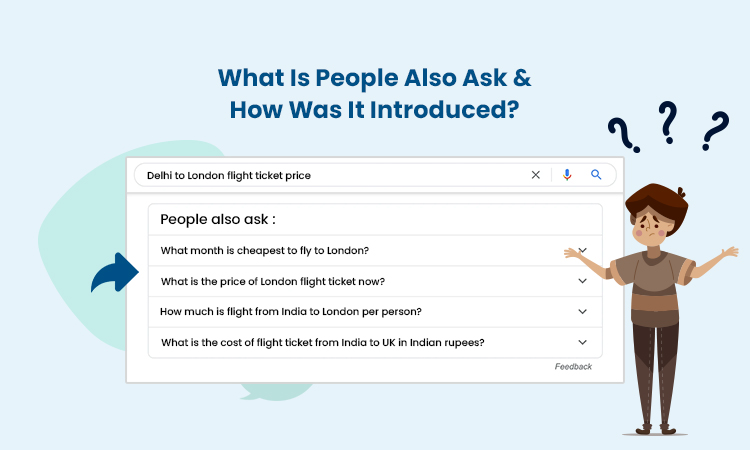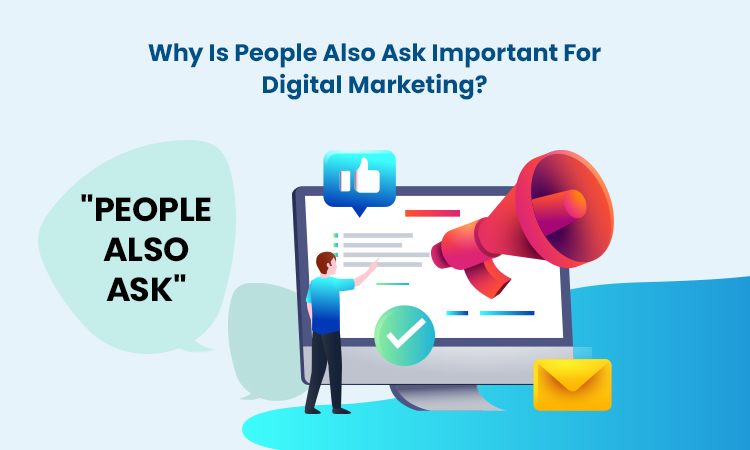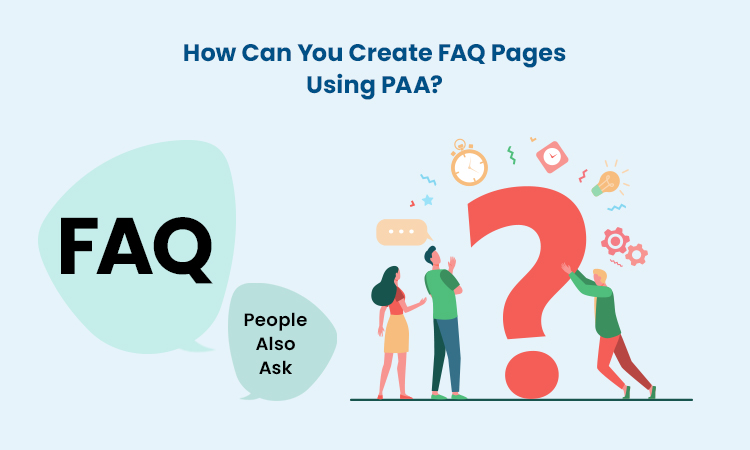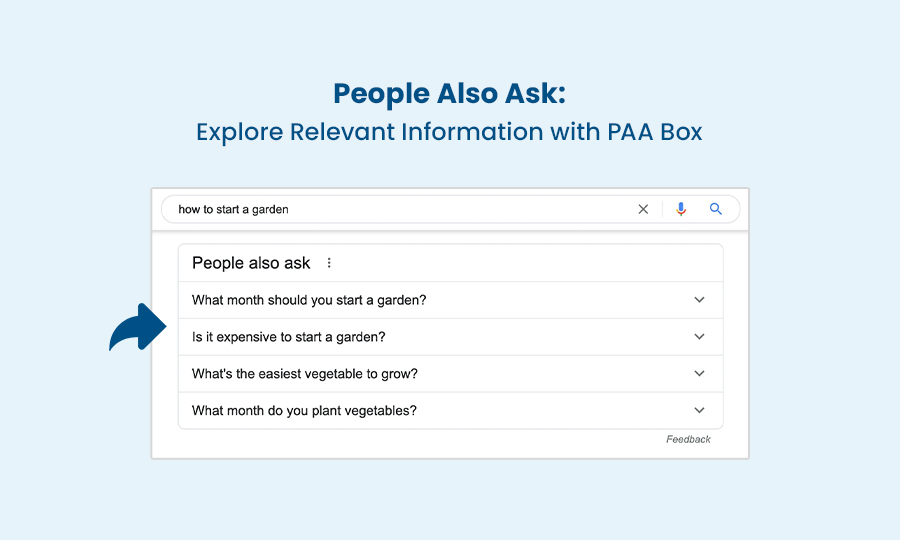Name any business you know, and it’s sure to have an online presence, though that might be limited to a small website. After all, people also ask prefer searching the web for any information, product, or service they might need from time to time.
That’s why all businesses are striving to achieve a leading SERP rank to be seen and known by potential customers. The People Also Ask (PAA) feature is significant in this regard as it has helped innumerable businesses gain considerable traffic. But getting a place in a People Also Ask box can be challenging— you need to understand what PAA really means and formulate an effective strategy to get the desired results.
Don’t worry; we’re here to guide you through the process. So, do stay with us till the end.
What Is People Also Ask And How Was It Introduced?

Google People Also Ask is the feature of a SERP that provides searchers with added questions linked to the original query along with quick answers. Usually, every question in the People Also Ask box comes with a featured snippet for the query.
Notably, the answer is sourced from a web page that you can log into for extra information. The answers may even come in different formats. And they may include lists, paragraphs, images, tables, and videos.
Another interesting aspect of Google People Also Ask is that the questions available in this section are infinite. When you click on a specific question, the PAA list will expand further with several associated queries.
At the start of 2022, Google People Also Ask boxes comprised around 60% of the search queries on a SERP. But a considerable drop was noticed in July 2022.
Why Is People Also Ask Important For Digital Marketing?

From April 2015 when People Also Ask questions were first tested by Google in its search results, the number of pages with such results has increased substantially. A major part of the increase took place in the recent few years and this has turned the feature into a lucrative opportunity for businesses to enhance their visibility in the SERPs
Interestingly, the percentage of SERPs featuring Google People Also Ask results is higher on mobile 52.27% than on desktop 49.37%. This is least likely to come as a surprise as most people spend a long time browsing on their mobile devices. Google seems to be urging users to spend lesser time typing on any device and is striving to provide quicker-loading results. Moreover, the proportion of People Also Ask results in a SERP has increased by 200% since August 2018.
The majority of countries have witnessed an increase in PAA boxes for desktop search results. Also note that the UK had the highest market share of Google searches in desktop searches, far surpassing other countries with a percentage of 86.31. Likewise, there has been a substantial rise in the Google People Also Ask results in the past year for the majority of countries that were part of the study.
Likewise, the People Also Search For feature on Google search is another significant tool for effective research on a varied range of topics. That’s why this feature can also attract a huge number of visitors to your webpages if you optimize them for the most popular PASF terms for your niche. Also, such terms act as suggestions for understanding the preferences and interests of the target audience. To know more about People Also Search For and optimizing your digital presence for ranking in this section, do visit our comprehensive guide on the topic.
How Can I Get My Content on ‘People Also Ask’?
Though getting a place in the People Also Ask boxes isn’t any rocket science, it’s not too easy either. You need to start by finding relevant questions and adding them to the on-page elements of a webpage. As a result, the chance of getting ranked in these boxes will increase drastically.
You should also be careful not to choose questions at random. That will cause your site to feature on the People Also Ask boxes for low-volume keywords. Ultimately, Google will send limited searchers to your site, which may not be of any good. That’s why you’ll need to optimize relevant questions containing a number of high-volume keywords.
After we’ve looked at the basics, let’s move on to the process of getting ranked in the Google People Also Ask boxes.
Step 1: Search for web pages already ranking in PAA for many keywords
The toughest part of optimizing content for People Also Ask is finding all keywords that Google utilizes to create particular questions. That’s why the best way out is to focus on finding questions that would cover many keywords with good search volume.
To get such questions, you’ll have to search for web pages that rank for many keywords. Ahref’s Site Explorer is a great tool for this purpose, and you should follow this up with the “Top Pages” report. Finally, use the keyword column and then set the search from high to low.
Step 2: Check the Search Term Rankings
Next, you’ll need to extract the ranking keywords using Ahrefs Site Explorer yet again followed by the Organic Keywords section. You’ll then get all the keywords that the page is ranking for.
But the keywords should be filtered effectively to get the ones that can truly help you rank in the People Also Ask section. Here are the criteria you’ll need to consider:
- Keywords appearing in the positions < 20
- Keywords with a search volume of at least 10 per month.
Step 3: Collect the PAA Questions That Are Helping Webpages Rank Higher
After you’ve found the web pages and keywords to rank for, you need to find proper questions associated with such pages. We’d recommend searching for the most commonly asked and popular questions in this regard.
Remember that it’s always wise to optimize the web pages of your site for the questions occurring for thousands of keywords.
After you’ve extracted the keywords with high search volume, make sure to export CSV files for those keywords by selecting “Export” from the top-right. You can then filter the keywords containing “PAA” in the column named “SERP features”.
Step 4: Check the Eligibility to Rank in A PAA Box
Generally, the People Also Ask box is occupied by top-ranked websites sitting in the top 10 positions. For example, while you’re searching with the focus keyword “Top 10 hill stations in the world”, you’ll spot just the top 10 websites in the Google People Also Ask box.
That’s why you’ll need to ensure the website ranks in the top 10 search positions for the keyword or question to get a webpage into the People Also Ask box. In case it isn’t getting such a rank, make sure to improve the ranking of the website or alter/rephrase the question you’re optimizing the site for.
Step 5: Optimize Your Content and the Web Page
Once you find the questions that are searched the most for some specific keywords, you’ll need to add them to the content and optimize the webpage. Ensure the webpage includes answers to such questions and Google finds the webpage worthy of inclusion in the People Also Ask boxes.
In case the question isn’t answered in a comprehensive way, it can be tough to secure a rank in the People Also Ask boxes. That’s why we’d recommend creating an answer that’s well-optimized and includes other content types such as audio, tables, stats, images, and video. This will ensure the searcher is satisfied with the answer.
Another point worth noting is that relevance and quality are two factors that drive the maximum traffic. As such, make sure to follow the schema markup approach while you form the content structure. This will improve your chances of featuring in the People Also Ask or Google Snippets section.
All in all, the task of getting your content featured on the People Also Ask section is best managed by an experienced SEO agency India. Such an agency can offer quality SEO services to rank your content on PAA, optimizing for questions that have the highest search volume. Using Google analytics, Google keyword Planner, and other such tools is imperative to such an optimization process.
Using PAA for content Ideation
A. Understanding users’ browsing journeys and intent
The search intent of a user, also known as user intent or customer intent, is the main reason behind a user consulting a search engine and entering a search query. A visitor to a search engine has a particular goal that they want to accomplish using their search.
As of today, every internet user utilizes a search engine multiple times to research a specific product or to find the answer to a question. And the smartphones of today are no less than a mobile search engine in the pocket.
Now, the search intent of a user influences their browsing journey as potential customers. That’s why marketers need to identify the part of the journey a customer is at when they’re typing a particular phrase and the landing page or content that should be targeted with the phrase.
The People Also Ask feature can be helpful in figuring out the search intent and understanding the browsing journey of a user at different points in time. Here’s how you can best utilize this feature for this purpose:
Interact with PAA questions
Ensure that you devote your attention to the relevant and interesting questions relating to your search. That’s because Google personalizes questions added on the basis of your interactions. Clicking on a particular question will cause adjacent questions to pop up that would provide a better idea about the search intent.
Download a web scraper extension
A web scraper will help you gather all the People Also Ask questions in one place so that you can analyze them later to understand the search intent. The following steps will outline how you’ll have to use web scraper for this purpose:
Step 1: Click on Google People Also Ask box to expand all the relevant answers, and you’ll find new questions popping up at the bottom.
Step 2: Repeat the process till it seems that you’re being shown similar questions.
Step 3: While you have the Scraper extension downloaded and in active status, you’ll need to right-click on a question in People Also Ask and select “Scrape Similar” from a dropdown menu.
Step 4: In the popup window, under the section Selector input, delete the square and number brackets.
Step 5: Now, you’ll need to rescrape the content using the “Scrape” button
Step 6: Finally, copy the scraped answers by hitting “Copy to clipboard”.
Remove The Questions That You Didn’t Click On
The scrape will work by default to scrape all questions and answers irrespective of whether you had clicked on them.
Among the list of inputs, you’ll need to place your top-level tag for the top inputs. And for the columns, you can map tags under the top tag and name them.
Then save this in the form of a “Preset”- just select the “Presets” button in the right hand side bottom of popup, name the present, and hit “Save”. You can then have the questions saved permanently in your system.
We’d recommend exporting the data to Google Docs, but only with the clicked answers in the “C” column. Click on that column and navigate the “Data>Create Filter” menu. Then click on the “Filter by condition” option and choose “Is not empty”. As a result, you’ll be able to see just the questions and answers you clicked on.
Marketers can then start sorting the data by questions that are similar and identify patterns that can be turned into a checklist of items or topic clusters to cover in an upcoming post.
B. Using Text Optimizer to identify related questions
Text optimizer refers to a tool used to extract concepts and terms from SERPs through semantic analysis to yield a list of questions worth including in a content piece. Extracting questions from a People Also Ask box and optimizing them using this tool can provide you a vast range of content ideas.
Do note that the tool supports Bing and Google. You may even paste the text onto the tool— it can then suggest the questions and terms to optimize the content better for any search engine.
C. Structuring content with questions as subheadings
People Also Ask questions can provide marketers with relevant and truly effective subheadings to include in their blogs. As a result, your content would have the ideal structure for ranking high on search engines. This is sure to attract an increasing number of customers to the website.
Many businesses nowadays depute the task of content ideation to well-known and efficient digital marketing agencies across the country. Do note that the best digital marketing agency India will generate a content strategy that matches your goals for ranking on PAA. In other words, the content will be centered around the most searched PAA questions in your niche.
How Can You Create FAQ Pages Using PAA?

The thumb rule for curating FAQs is that they should comprise the most common queries among all users. Though this sounds simple, it involves brainstorming questions that are asked the most by users. You’ll need to refer to extensive data in this regard, as that can clearly define the questions commonly searched by users.
Speaking of People Also Ask results, they display questions closely associated with the intent of a user for particular keywords. Use Google People Also Ask results shown for relevant keywords to fill any of the gaps on the FAQ pages.
Conclusion
All in all, building a specific strategy to rank in the Google People Also Ask results is essential if you want to surpass your competitors in terms of traffic inflow and lead generation.
Similar to featured snippets, you’re likely to win People Also Ask features quickly. That’s why it’s worth leading a strategy for SEO using such tactics to achieve a rank above the “blue link” search results. Go ahead and start your research on the most suitable queries for People Also Ask boxes relevant to your business. If you have any more queries in this regard, feel free to get in touch in with us. We’d be happy to help!
Additional Resources:

